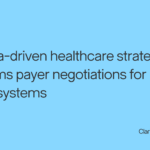Ines Vigil, MD, MPH, MBA, FACPM, is the GM and SVP of Provider Solutions at Clarify Health. She has over sixteen years of leadership experience in healthcare and population health, working with providers and organizations in the areas of value-based care delivery, social & behavioral determinants, healthcare quality improvement, data analytics, informatics, and preventive and occupational medicine. In this video, Dr. Vigil outlines three key strategies that will set your organization up for success in value-based arrangements. Video transcript: Setting up a strong foundation of growth in fee-for-service is a critical element to understanding and negotiating mutually successful value-based care arrangements. More so now than ever before, the growth strategy a care delivery organization pursues will inherently define its value strategy. If you are a Chief Strategy Officer, or working to develop the strategy for your care delivery system, you need to plan for growth as you prepare for a value-based future. I’m Dr. Ines Vigil, and I am as passionate about data-driven decision-making as I am in helping provider and payer organizations set themselves up for success in both fee-for-service and value-based care delivery. I serve as the GM and SVP of Provider Solutions for Clarify Health. And prior to joining, I co-wrote and edited a first-of-its-kind population health analytics textbook, aimed at training the future healthcare workforce in using data to succeed in the business of healthcare. Prior to that, I’ve worked with provider, payer, and government healthcare organizations across the US for more than 15 years, helping them to advance their use of data to improve care delivery, affordability, and quality. Let’s dive right into creating three growth recipes for success to set your organization on a path to success in value-based arrangements. First and foremost, optimize your site of service triage, footprint, and operations. Start by developing a strategy for what and how you would move existing inpatient care delivery to lower-level care settings. Include in your strategy a data-driven approach to which services to move and why, how moving these services may enhance or diminish the patient’s and the provider’s experience, and what the short and long-term financial gain or loss would be generated by these actions. Additionally, create a set of net new outpatient and ambulatory care services, infusion services, imaging, and or lab services. It is critical to involve your clinical service line leaders and financial teams to assess the clinical and financial trade-offs and implications of moving or generating net new services with high profitability. By developing a data-driven strategy for your organization’s site of service delivery, you’ll reduce the risk of selecting inappropriate and administratively burdensome services, you’ll improve the experience of patients and their providers, and ensure you will grow profitably over time. Second, create a data-driven growth strategy informed by patient utilization patterns. Traditionally, fee-for-service growth strategies were formed based on physician practice patterns. Now, with healthcare consumerism rising and patients directing their care needs more and more, you need more insight into the demands, the patterns, and the purchasing power of patients to deliver the healthcare experience they have come to expect. Taking a patient-centered approach to tailor care to the needs of patients within their geographic footprint will enable patient growth and loyalty, grow market share and select services, and generate net new revenue based on your population’s health and social needs, uniquely matched to the services where your organization excels. Third, understand the impact of referrals on your organization’s profitability and the performance on cost quality and utilization. Care delivery organizations that are successful in both fee-for-service and value-based care delivery develop strategies that combine creating new referral opportunity and optimizing existing referrals with benchmarked specialty care performance on cost, quality, and utilization metrics. Performance benchmarks must be accurate, transparent, and fair, using case-mix adjustments for specialty-specific factors that take into account the acuity, the chronicity, and the social determinants across patient panels, regions, and their comparison groups. Improving your fee-for-service referral strategy with an understanding of baseline and historical performance on cost, quality, and utilization will leapfrog your organization to enabling success in increasing in-network volume as well as the likelihood to succeed in delivering high-value care. There are many ways to create your growth to value recipes for success. The three data-driven strategies for success shared with you today, optimizing site of service, incorporating patient utilization patterns, and managing high-value care referrals will not only focus your organization’s valuable resources on what is most important to your organization’s financial well-being, meeting patient needs and growing profitably, it will also enable you to develop win-win, value-based risk arrangements with payers for years to come.
- Author Details





